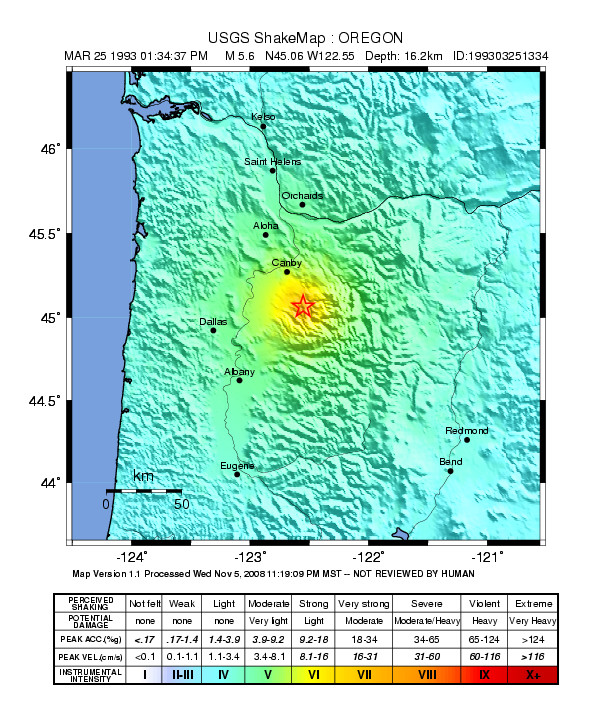Earthquake Magnitude vs. Shaking Intensity; ShakeAlert Provides Estimates for Both
We are partnering with ShakeAlert, the United States earthquake early warning system, to keep you informed about earthquake risk in Oregon and how you can mitigate damage from earthquake shaking. We began this series by talking about earthquake hazards in Oregon, now let’s shift focus to the differences between earthquake magnitude and intensity.
Magnitude is the measurement of the size of an earthquake and likely something you are familiar with. An earthquake’s magnitude correlates to how much of the crust’s surface was ruptured and therefore how much energy was released during the earthquake. The more energy released, the bigger the earthquake magnitude. It is important to understand that the magnitude scale is not linear - it is logarithmic. This means that a single unit increase in magnitude actually represents 32 times more energy! For example, a magnitude 6 earthquake releases 32 times the energy of a magnitude 5 earthquake. A magnitude 7 earthquake releases 64 times the energy of a magnitude 5 earthquake.
The second way we measure earthquakes is by earthquake intensity. Intensity is a measurement of the severity of shaking someone experiences during an earthquake. An earthquake will have only one magnitude but will have many intensities. Intensity varies depending on where you are because it depends on MANY factors: earthquake magnitude, your distance to the rupturing fault, the local soil or rock type under your feet, and building construction, among other things. A greater magnitude earthquake equates to greater shaking intensity everywhere.
You may have heard of the Modified Mercalli Index (or MMI) - this is the scale shaking intensity is measured against. Each roman numeral represents a quantitative amount of shaking (e.g. the percentage of gravity you feel pulling on you during shaking) as well as a qualitative amount of shaking (e.g. things fall off of shelves with moderate shaking intensity).
A lightbulb is a good analogy when talking about magnitude and intensity. Magnitude is fixed, like the wattage of a lightbulb. You can have a 25 or 100-watt lightbulb, but it is a fixed amount of power that does not change. Intensity is like the amount of light received at any spot in the room from that lightbulb. The closer you are to the light, the more intense, or bright, the light is, but the further you are away, the less intense, or fainter, the light is. The magnitude of the lightbulb did not change, but the intensity of light depends on your distance away from the lightbulb. (source IRIS)

Often on the local news you will hear reports on an earthquake’s magnitude and where the earthquake epicenter is located. However, what really matters is your proximity to the fault rupture. An earthquake is not a dot on a map. Instead, the rupture surface grows along a plane, represented as a fault line at the surface of the Earth. Initially, you may be far from the epicenter, but as the earthquake grows and more of Earth’s surface ruptures, you may end up being very close to the final fault rupture. Initially you would feel light shaking. But as the rupture grows and moves closer to you, the shaking intensity grows stronger. This is an important point and speaks to the benefit of ShakeAlert. Because it takes time for the earthquake to grow and the rupture to reach you, a warning would provide you situational awareness and time to get to a safe place and take protective action. A ShakeAlert estimates both the earthquake’s magnitude and the shaking intensity at a particular location, and in many circumstances can deliver this information prior to the arrival of shaking at a location. The next article in this series will speak to how the ShakeAlert system works. Stay tuned!
To learn more about the earthquake hazards around your home or office, refer to these hazard map resources in our state:
- Oregon Department of Geology and Mineral Industries (DOGAMI) Statewide GeoHazard Viewer: https://www.oregongeology.org/hazvu/
- Oregon State Hazard Explorer: https://ohelp.oregonstate.edu/
